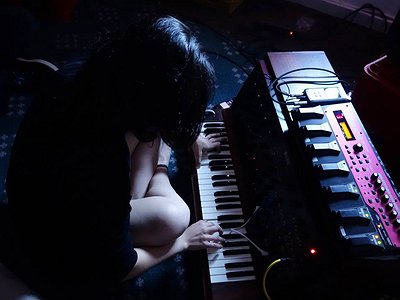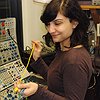Part 2
Could you describe your creative process on the basis of a piece or album that's particularly dear to you, please? Where do ideas come from, what do you start with and how do you go about shaping these ideas?
It’s like the first part of that totally life-affirming Yes song, “I’ve Seen All Good People” from that totally life-affirming Yes album, The Yes Album. Just like that, in fact. It’s so lovely the way it builds, so subtle and simple, with everything clear and in its place. At the heart of it, John and Chris are just telling you not to surround yourself with yourself and that, you know, it’s time in time with your time over and over again and Bruford is barely doing anything, just keeping steady until the B section, and then those recorders and that Hammond organ come in and, god help us all, the whole thing is brilliant. And, when things aren’t going so well it’s a bit more like “Sometimes I Don’t Know What to Feel”, but I take comfort in the warm wisdom of Rundgren’s bridge: “Everything will be cool, I’ve got to keep on keeping on, there’s nothing else I can do.” Know what I mean? Ideas seem to just sort of spring up on their own for me, which is occasionally frustrating because I’ll force myself to think about something for a while and nothing comes that’s ever quite as good. Usually, the right idea will just present itself at some random time, from any random source. Often it happens at night, like I seem to get all my best ideas when it’s dark and quiet out and most well-adjusted people are asleep. These sorts of ideas come to me fairly fleshed out conceptually, but once they’re around it then becomes a matter of giving the thing time to develop in details. I write things out a lot, but probably just the right amount. Once I have enough to work from it’s usually pretty clear the direction that needs to be taken to get things moving. I’m pretty straight ahead in my purpose; I don’t veer too far once I have something going. If I happen to think of something else in the midst, I usually finish the first thing and then dedicate the new idea to something separate. Usually.
With more and more musicians creating than ever and more and more of these creations being released, what does this mean for you as an artist in terms of originality? What are some of the areas where you currently see the greatest potential for originality and who are some of the artists and communities that you find inspiring in this regard?
I think originality is a weird concept. It doesn’t function as a succinct phenomenon because you’re always bringing past influences and experiences into what you do; even if one were trying to precisely emulate something else, it’s inevitably going to manifest as something new because it’s coming from a different ear and hand. I’m pretty keenly interested in musical instruments in their role as both objective sound sources and meaningful historical objects, and I think there is a lot of potential in each and every one, but especially in those that may have been left behind or forgotten in the crooks of time. I don’t like the idea of fetishizing objects and deifying their makers, and I’m as much a sucker for sentimentality and nostalgia as the next guy, but I think that the sensual thing-ness, if I may get Heideggerian for a brief moment, of most musical instruments and their inherent tones has been largely eclipsed by narrative and connotation. I’d like to see the acoustics and construction/design involved in these objects be increasingly returned to the vast sweep of the chronosphere, all things being equal. I guess I find any artist that is privy to the simple wonder of the object or timbre in itself pretty inspiring, whether that be Ennio Morricone slapping human humming and somewhat erotic breathing alongside a pipe organ, or Oren Ambarchi incorporating a Leslie 122 with its characteristic Doppler effect into his set up, or Black Sabbath slipping that unadorned and totally stunning tremolo into the wildly gentle “Planet Caravan”, or Fleetwood Mac mirroring the haze of the guitar with some fairly unassuming but nonetheless haunting honky-tonk piano in “Sara”. It’s all pretty special when you consider the details.
How strictly do you separate improvising and composing?
They certainly overlap in what I do. When I’m performing live I pretty much know how 90% of the whole affair is going to fall into place. I like having a structure to work from, and, in what might seem like a counterintuitive way, I find having structure to be quite freeing because it gives you a starting point from which other tangible paths can develop in real time if it feels right. When I’m composing, regardless of whether it’s for a fixed piece or a live piece, mostly everything is derived from a series of experimentations. Of course, I have certain ideas and shapes and textures in mind, but I definitely leave a lot of room for the presence of the other to make itself known.
How do you see the relationship between sound, space and composition and what are some of your strategies and approaches of working with them?
As far as I can tell, sound and space – whether it’s real space or mental space – are inextricably linked. It’s a completely fascinating thing to consider, I think, since it manifests in so many ways, each with a slightly different but equally meaningful result. Of course, the physical space in which sound is projected has great import on the experience of both the listener and the creator. Part of that is just the vibe of the space, but the better part of it has to do with the impact that the acoustics and resultant psychoacoustic effects impart on the overall sound. It’s no simple coincidence that churches happen to be highly reverberant spaces; they were designed so as to destroy any element of localization from whatever sound happened to be circulating, thus imitating divine omnipresence. The composer R. Murray Schafer, who is something of a national treasure here in the Great White North, posited that the history of music could be traced according to the development of the buildings and physical spaces for which it was intended, and I think that’s a really beautiful way to consider the connection between sound and architecture. Naturally, I think that the space of recorded music is perhaps the most interesting, because it really has completely changed the way we intake and appreciate sound and it’s begun to edge its way toward a highly intimate connection with the sort of irreal spaces of our imaginations and memories. It’s clear if you consider the unbelievable detail of layer and overwhelming depth of tone we can acquire in the recorded sphere. Like even just with direct stereo imaging, for instance--any Beatles record will convince you of that within the first two minutes. Then there’s the other melding of real and mental space that you get when you deal with psychoacoustic effects, which is what I try to do. In Indian classical music there’s this practice where a group of musicians listen intently to a held tone – on a harmonium, say – and derive the pitches that comprise those of the raga on the overtones that naturally emerge from the drone over time. I think that’s such an amazing way to really get into the world of the sound itself, which is not something most people are accustomed to doing actively. Anytime you have two or more frequencies overlapping you’re going to get additional harmonic and inharmonic artefacts that are born of the discrepancy or space between, and singular complex timbres that inherently contain multiple harmonics will always disclose their innards if given the chance to unfold. Fallible humans perform acoustic instruments, so things are never going to stay perfectly in tune even if the aim is to sound at the same frequency, and that’s where all the spectral richness comes in; analog synthesizers operate in a mutual manner since their oscillating components are so unstable, even if only slightly. It’s this sort of basic phenomenon that makes music so lush and spacious, as one might say. And it’s not just in non-Western or experimental music that this comes up: go drown yourself in those agonizingly gorgeous overtones Page coaxes from his guitar in the opening of “Going to California” on some wintry afternoon and you’ll get why that’s really one of Zeppelin’s best songs. Acoustics and psychoacoustics aside, there is, of course, also the general feel of a physical space that can affect the listener or creator. I’ve definitely found solace in many different kinds of spaces, all of which are remarkable in their own way. Airplanes in particular seem to do it for me for some reason; something to do with the serenity/horror of passing through the embrace of the mighty Nothing in the fragile labour of your species, my best guess. Lastly, I would say that there’s also the private headspace that you, as a listener, create solely for yourself. No matter the specific contents, I think that listening is always some sort of consuming, multi-dimensional experience, drifting somewhere between mobility and suspension. So, in a way, it’s always like you’re kind of dwelling inside sound for a while, and that’s got a lot to do with space, too. It really is all about space, man.
What's your perspective on the relationship between music and other forms of art – painting, video art and cinema, for example – and for you and your work, how does music relate to other senses than hearing alone?
Oh, there are endless parallels one could draw. I like to think of sounds as these worlds that you enter into, not as a form of escapism, but rather as an act of emotional or aesthetic disclosure. Other art forms do exactly the same thing as far as I can tell; they just take a slightly different path to get there. I often think of sounds in terms of colour or texture especially. That being said, I tend to like to focus on singular senses at a time so as to really appreciate each offering in itself. I’m the type of asshole who finds accompanying visuals really distracting unless they were paired with intention. I also see a lot of fundamental relationships between music and architecture, as I think sound is very much a spatial experience. Music is a curious medium because it’s pretty abstract and ephemeral, occasionally more like a language than an impression. People are of course more comfortable with the visual realm, and I guess the notion of describing or acknowledging the effect of sound makes us feel uneasy and awkward sometimes. It’s disappointing, to be sure, and unfortunately I don’t think that that perception is changing for the better.








